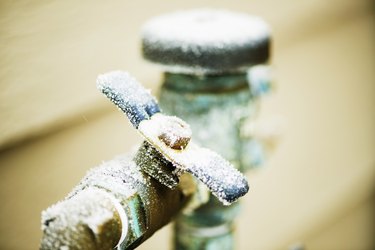We've stumbled upon this article about Preventing and dealing with frozen pipes below on the internet and reckoned it made good sense to quickly share it with you on my blog.

Winter can ruin your plumbing, particularly by freezing pipelines. Here's how to prevent it from happening and what to do if it does.
Intro
As temperature levels decrease, the threat of frozen pipes rises, potentially leading to pricey repair services and water damage. Recognizing exactly how to avoid frozen pipes is essential for homeowners in cool climates.
Understanding Icy Pipes
What causes pipelines to freeze?
Pipelines freeze when subjected to temperatures below 32 ° F (0 ° C) for extended durations. As water inside the pipes freezes, it increases, putting pressure on the pipe wall surfaces and possibly causing them to rupture.
Threats and damages
Frozen pipelines can bring about supply of water disturbances, home damages, and pricey repairs. Burst pipes can flooding homes and create considerable structural damage.
Signs of Frozen Piping
Determining frozen pipes early can stop them from bursting.
How to identify frozen pipelines
Look for lowered water circulation from taps, unusual odors or noises from pipes, and visible frost on subjected pipes.
Prevention Tips
Insulating susceptible pipes
Cover pipes in insulation sleeves or use warmth tape to shield them from freezing temperature levels. Focus on pipelines in unheated or exterior areas of the home.
Home heating strategies
Keep indoor areas effectively warmed, particularly areas with pipes. Open closet doors to allow warm air to distribute around pipes under sinks.
Securing Outdoor Pipes
Garden tubes and exterior faucets
Detach and drain pipes garden tubes before winter season. Install frost-proof spigots or cover outdoor faucets with shielded caps.
What to Do If Your Pipes Freeze
Immediate actions to take
If you believe frozen pipes, keep taps open up to alleviate pressure as the ice melts. Make use of a hairdryer or towels taken in hot water to thaw pipelines slowly.
Long-Term Solutions
Architectural adjustments
Think about rerouting pipelines far from outside wall surfaces or unheated locations. Include added insulation to attic rooms, cellars, and crawl spaces.
Updating insulation
Buy top quality insulation for pipelines, attics, and walls. Proper insulation helps maintain consistent temperature levels and lowers the threat of icy pipes.
Conclusion
Avoiding frozen pipelines calls for positive steps and quick feedbacks. By recognizing the causes, signs, and safety nets, house owners can safeguard their pipes during winter.
5 Ways to Prevent Frozen Pipes
Drain Outdoor Faucets and Disconnect Hoses
First, close the shut-off valve that controls the flow of water in the pipe to your outdoor faucet. Then, head outside to disconnect and drain your hose and open the outdoor faucet to allow the water to completely drain out of the line. Turn off the faucet when done. Finally, head back to the shut-off valve and drain the remaining water inside the pipe into a bucket or container. Additionally, if you have a home irrigation system, you should consider hiring an expert to clear the system of water each year.
Insulate Pipes
One of the best and most cost-effective methods for preventing frozen water pipes is to wrap your pipes with insulation. This is especially important for areas in your home that aren’t exposed to heat, such as an attic. We suggest using foam sleeves, which can typically be found at your local hardware store.
Keep Heat Running at 65
Your pipes are located inside your walls, and the temperature there is much colder than the rest of the house. To prevent your pipes from freezing, The Insurance Information Institute suggests that you keep your home heated to at least 65 degrees, even when traveling. You may want to invest in smart devices that can keep an eye on the temperature in your home while you’re away.
Leave Water Dripping
Moving water — even a small trickle — can prevent ice from forming inside your pipes. When freezing temps are imminent, start a drip of water from all faucets that serve exposed pipes. Leaving a few faucets running will also help relieve pressure inside the pipes and help prevent a rupture if the water inside freezes.
Open Cupboard Doors
Warm your kitchen and bathroom pipes by opening cupboards and vanities. You should also leave your interior doors ajar to help warm air circulate evenly throughout your home.

We were made aware of that write-up on How to prepare your home plumbing for winter weather through a pal on another site. Are you aware of someone else who is excited about the subject? Do not hesitate to promote it. Thank you for your time spent reading it.
Call Today